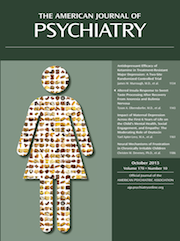To the Editor: Perturbations in the CSF concentrations of amyloid-β
1–42 (decreased), total tau (increased), and phospho-tau (increased) of patients with Alzheimer’s disease relative to healthy comparison subjects is a well-replicated finding and is thought to reflect retention of amyloid-β in the brain parenchyma together with tangle formation and neuronal and axonal degeneration (
1). We recently reported (
2) an increased velocity of decline in working memory and orbitofrontal metabolic deficits associated with Alzheimer’s disease with psychosis in participants in the Alzheimer’s Disease Neuroimaging Initiative (ADNI), suggesting accelerated frontal pathology. The excess cognitive impairment that manifests in Alzheimer’s disease with psychosis appears to predate the onset of psychosis (
3), suggesting that psychosis is the expression of a distinct pathophysiology rather than a driver of decline. No studies to our knowledge have investigated the ability of CSF core biomarkers, as a reflection of disease pathology, to distinguish between Alzheimer’s disease with and without psychosis. Here, we present an analysis of data from participants in the ADNI study, in which individuals were retrospectively divided into groups of eventual Alzheimer’s disease with psychosis or Alzheimer’s disease without psychosis during the study period, and baseline core CSF Alzheimer’s disease biomarkers were compared.
Data used in this analysis were obtained from the ADNI database (
adni.loni.ucla.edu). The primary goal of ADNI (a longitudinal follow-up study) has been to test whether serial MRI, positron emission tomography, other biological markers, and clinical and neuropsychological assessments can be combined to measure the progression of mild cognitive impairment and early Alzheimer’s disease. Determination of sensitive and specific markers of very early Alzheimer’s disease progression is intended to aid researchers and clinicians in developing new treatments and monitoring their effectiveness and in lessening the time and cost of clinical trials. ADNI is the result of efforts of many co-investigators from a broad range of academic institutions and private corporations, and individuals have been recruited from over 50 sites across the United States and Canada. The initial goal of ADNI was to recruit 800 adults, ages 55 to 90, to participate in the research: approximately 200 cognitively normal older individuals to be followed for 3 years, 400 individuals with mild cognitive impairment to be followed for 3 years, and 200 individuals with early Alzheimer’s disease to be followed for 2 years. For up-to-date information, see
www.adni-info.org.
Alzheimer’s disease with psychosis was defined by the presence of delusions or hallucinations as assessed by the Neuropsychiatric Inventory Questionnaire, a caregiver-based rating scale (
4). The Alzheimer’s disease without psychosis group comprised individuals for whom Neuropsychiatric Inventory Questionnaire data were available through the entire 36 months who had no delusions or hallucinations. Sixty case subjects who had CSF collected at baseline developed psychosis over the 36-month study period; 13 were psychotic at the first visit, and the remainder developed psychosis over the 36-month period. One hundred fifteen participants had CSF collected at baseline and remained nonpsychotic over the course of the study. Analyses of covariance on each of the three CSF measures were conducted comparing psychotic and nonpsychotic individuals. Age, gender, education, diagnosis at baseline, and global score on the Clinical Dementia Rating Scale were entered as possible covariates; if a covariate did not reach significance, it was deleted. Interactions with psychosis were entered into the analyses; if they were not significant they were deleted from the model. If psychosis was not significant, an analysis of variance was conducted, with the covariate becoming the main independent variable.
In CSF, the only significant protein biomarker interaction with psychosis was with total tau, such that the level of total tau in CSF was significantly elevated in participants who developed psychosis over the course of the study (
Table 1). Gender, as a covariate, interacted with both total tau and phospho-tau, but not amyloid-β
1–42; this interaction was independent of the interaction between total tau and psychosis. Diagnosis at baseline interacted with amyloid-β
1–42, such that individuals with Alzheimer’s disease at baseline had lower levels in CSF.
The observed elevation of tau may be a biomarker of the more rapid prepsychotic deterioration seen in Alzheimer’s disease with psychosis or may be a reflection of an increased burden of tau pathology, as elevations in CSF tau have been reported in association with neurofibrillary tangle density (
5). Elevation of total tau, rather than merely functioning as an Alzheimer’s disease state biomarker, has been associated with a more rapid progression from mild cognitive impairment to Alzheimer’s disease (
6), a more rapid cognitive decline (
7), and a higher mortality rate (
8). In fact, the magnitude of increase in total tau concentrations in the CSF is highest in disorders with the most aggressive neurodegeneration, such as Creutzfeldt-Jakob disease (
9). The data suggest that the accelerated decline in working memory and impaired orbitofrontal glucose metabolism recently reported (
10) in Alzheimer’s disease with psychosis in the ADNI cohort may be the result of advanced frontal neurodegeneration. Future studies investigating the neuropathological correlates of accelerated decline in Alzheimer’s disease with psychosis are necessary.

